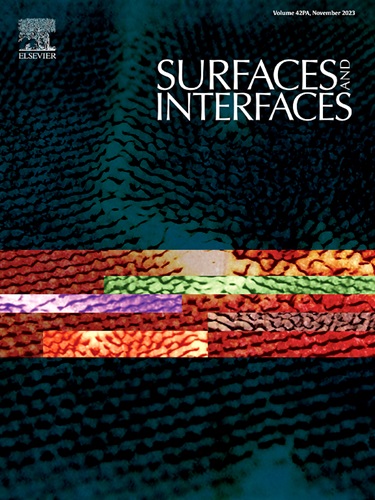Construction of a superhydrophobic surface with long-term durability on 5052 Aluminium for corrosion protection
IF 6.3
2区 材料科学
Q2 CHEMISTRY, PHYSICAL
引用次数: 0
Abstract
Superhydrophobic surfaces have been demonstrated to offer exceptional corrosion protection for metal surfaces. However, long-term stability issues have plagued superhydrophobic surfaces. In this study, a durable superhydrophobic surface on aluminum (SHC-Al) was created using etching combined with anodizing followed by polydimethylsiloxane (PDMS) modification. To optimize the multi-scale rough structures, the optimal anodizing conditions were explored in detail. The superhydrophobic surfaces were analyzed using Field emission scanning electron microscopy (FESEM), Confocal laser microscopy (CLSM), X-ray energy spectrometry (EDS), Fourier transform infrared spectrometry (FTIR), X-ray photoelectron spectroscopy (XPS), contact angle (CA) measurements, stability tests, and electrochemical analysis. The results reveal the successful preparation of a nest-like micro-nano composite structure on metal surface, and the contact and sliding angles of SHC-Al were measured at 157.6° and 6°, demonstrating the formation of excellent superhydrophobic surface. Electrochemical tests showed a corrosion current density of only 1.38 × 10–9 A∙cm-2 for SHC-Al, with a corrosion inhibition efficiency of 99.97 %, highlighting its outstanding anti-corrosion performance. Furthermore, stability tests demonstrated the SHC-Al surface had long-term durability. This study not only provides new evidence for the preparation of long-lasting superhydrophobic surfaces, but also provides a new solution for the practical application of superhydrophobic surfaces.

在 5052 铝材上构建具有长期耐久性的超疏水表面,以提供防腐蚀保护
事实证明,超疏水表面可为金属表面提供卓越的防腐蚀保护。然而,长期稳定性问题一直困扰着超疏水表面。在本研究中,利用蚀刻结合阳极氧化,然后再进行聚二甲基硅氧烷(PDMS)改性,在铝材(SHC-Al)上形成了持久的超疏水表面。为了优化多尺度粗糙结构,详细探讨了最佳阳极氧化条件。使用场发射扫描电子显微镜(FESEM)、共聚焦激光显微镜(CLSM)、X 射线能谱仪(EDS)、傅立叶变换红外光谱仪(FTIR)、X 射线光电子能谱仪(XPS)、接触角(CA)测量、稳定性测试和电化学分析对超疏水表面进行了分析。结果表明,在金属表面成功制备了巢状微纳复合结构,并测量出 SHC-Al 的接触角和滑动角分别为 157.6°和 6°,表明形成了优异的超疏水表面。电化学测试表明,SHC-Al 的腐蚀电流密度仅为 1.38 × 10-9 A∙cm-2,缓蚀效率高达 99.97%,凸显了其卓越的抗腐蚀性能。此外,稳定性测试表明 SHC-Al 表面具有长期耐久性。这项研究不仅为制备长效超疏水表面提供了新的证据,也为超疏水表面的实际应用提供了新的解决方案。
本文章由计算机程序翻译,如有差异,请以英文原文为准。
求助全文
约1分钟内获得全文
求助全文
来源期刊

Surfaces and Interfaces
Chemistry-General Chemistry
CiteScore
8.50
自引率
6.50%
发文量
753
审稿时长
35 days
期刊介绍:
The aim of the journal is to provide a respectful outlet for ''sound science'' papers in all research areas on surfaces and interfaces. We define sound science papers as papers that describe new and well-executed research, but that do not necessarily provide brand new insights or are merely a description of research results.
Surfaces and Interfaces publishes research papers in all fields of surface science which may not always find the right home on first submission to our Elsevier sister journals (Applied Surface, Surface and Coatings Technology, Thin Solid Films)
 求助内容:
求助内容: 应助结果提醒方式:
应助结果提醒方式:


